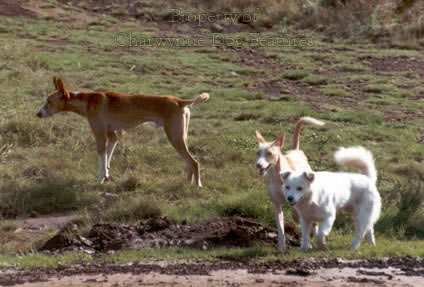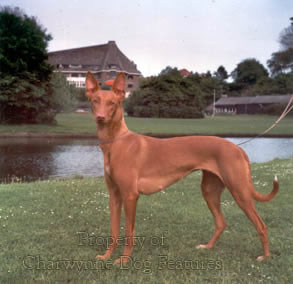35 THE WHIPPET OF SICILY
THE WHIPPET OF SICILY - a very special hunting dog
by David Hancock
 No doubt my title will offend some breed purists but it's intended to be a genuine compliment. A specialist on rabbit and hare, but so silent a hunter it can catch unwary feathered game too, this 18”, 23lb Sicilian Hound is largely unknown to British sportsmen, yet now has a small enthusiastic bunch of supporters here, where there are now around fifty. Officially recognised as the Cirneco dell’Etna, it has been linked with the foothills of Mount Etna in Sicily for many centuries. Resembling a reduced Pharoah Hound, being fawn, in all shades, with white markings permissible, it reminds me more of the Cretan Hound, but is much like the other podencos of the Mediterranean littoral. I have seen similar hunting dogs in Corsica, with the smallest variety of the Portuguese Podengo also being utilised by hunters in a comparable fashion. Rather like its sister breeds from that part of the world, the Cirneco dell’Etna has superb hearing, aided no doubt by the bat-ears, and really durable feet, a basic feature so overlooked by many lurcher breeders here.
No doubt my title will offend some breed purists but it's intended to be a genuine compliment. A specialist on rabbit and hare, but so silent a hunter it can catch unwary feathered game too, this 18”, 23lb Sicilian Hound is largely unknown to British sportsmen, yet now has a small enthusiastic bunch of supporters here, where there are now around fifty. Officially recognised as the Cirneco dell’Etna, it has been linked with the foothills of Mount Etna in Sicily for many centuries. Resembling a reduced Pharoah Hound, being fawn, in all shades, with white markings permissible, it reminds me more of the Cretan Hound, but is much like the other podencos of the Mediterranean littoral. I have seen similar hunting dogs in Corsica, with the smallest variety of the Portuguese Podengo also being utilised by hunters in a comparable fashion. Rather like its sister breeds from that part of the world, the Cirneco dell’Etna has superb hearing, aided no doubt by the bat-ears, and really durable feet, a basic feature so overlooked by many lurcher breeders here.
Talking to an enthusiastic Italian breeder at a World Dog Show about the breed, he described them in his fractured English as a Trotting Sleuth Hound, meaning not an active Bloodhound but a tracking dog with an effortless trotting gait in the hunting field, backed by ‘infinite versatility’. He stressed their remarkable hearing, based on extremely sensitive ears, highly mobile ears, which can act independently, each one responding separately to the noise most acute on that side. He was proud of their field capability ahead of their appearance, waxing eloquent about the field trials available in the breed. Perhaps fanciers like him have ensured that the breed is still very much a sporting one, not mainly an exhibitor’s dog.
These Sicilian hounds have their own field trial regulations, covering shooting over game and trials without guns. Around 150 hounds are newly registered there each year. It is worth noting that their field trial regulations stipulate that: Dogs that do not make a tenacious effort in their work; that hesitate on a scent trail; that are distracted and do not cover the ground designated for their turn within the first five minutes will be eliminated. They are used to working with ferrets and at 46 to 50 cms (18 to 20 inches) lack the legginess of the 22 to 29 inch Ibizan Hound, but display a squarer torso than the similar Pharoah Hound. Like the Cretan Hound they use an effortless energy-conserving trot in the hunt, relying more on their remarkable agility, superb hearing, keen sense of smell and lightning-fast reactions than sheer speed. Crossed with a Whippet, their blood would have much to contribute to our hunting dog scene, although I’m not sure that their bat-ears wouldn’t have problems in a climate famous for cold winds.
Dutch hound expert Leo Bosman links this breed with historic references to the Cane Cireneico, the dog of Cyrenaica, or eastern Libya of today, hinting at a desert origin. But others have held that the breed title comes from the Latin, cernere, to sift or separate (as in our word discern) or seek out or ‘sniff out’ its prey. Cyrenaica was based on the ancient Greek and then Roman city of Cyrene, with close trading links between Greece, Rome and the north African littoral. Sicily would be the closest part of Italy to Africa. Our word gazehound, using the original meaning of the word ‘gaze’, means a par force hound, shows how a name alone can indicate the function of hunting at force in a pack, as opposed to sighthounds that hunted by speed either singly or as a brace. The two words gazehound and sighthound are not synonymous. The Cirneco dell’Etna could have been ‘the hunting dog from the Etna area that fastened on to its prey using sight and scent’. Old breed names can usually be linked with function, as our pointers, setters, terriers, bouviers and retrievers all demonstrate.
It’s of interest that in Hutchinson’s Dog Encyclopaedia of 1934, a 3 volume summary of dog knowledge at that time, reference is made to the breed: “The Cernecchi are undoubtedly the Sicilian Segugi”- the latter being the racy, long-eared and drop-eared, 22”, 50lb hunting dogs, used on rabbit, hare and even boar, of mainland Italy. But going on to state “They are not coursing dogs, like Greyhounds, neither are they retrievers, or dogs going to ground, although many sportsmen use them for hunting rabbits.” This coverage points out that Sicilian sportsmen made use of a hybrid between the Cernecco and a pointing dog, used with ferrets and hunting with guile rather than speed. Sounds like a Sicilian lurcher to me! But today the purebred Sicilian hunting dog is worth a glance by sportsmen here.
Rigorously selected over centuries to hunt on terrain formed by volcanic lava, in extreme heat and in pursuit of an often under-rated quarry, the humble rabbit, this breed is robust mentally, physically hardy and relatively free from inherited defects. I have concerns about their being bred by non-hunting owners to resemble Italian Greyhounds – with the dreaded hackney front action favoured, and over their being bred bigger by some show-ring fanciers – to resemble small Pharoah Hounds, spoiling breed type. Abroad the breed is recognised as a ‘primitive type’ not as a sighthound. They are much more than sighthounds in the hunting field, sheer speed alone being of limited value in their hunting grounds. You could argue too that our lazy division of hounds into just two categories, sight and scent-hounds, is in itself somewhat ‘primitive’. We should always recognise diverse talents in hunting dogs, and this little breed has talent in abundance. The early imports into Britain appear to be in good hands and that is very good news indeed. This is a hunting breed that really deserves to prosper.